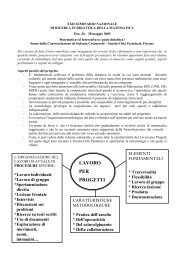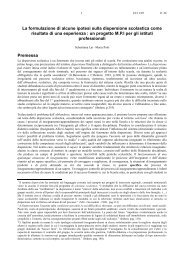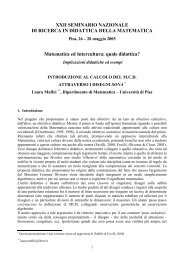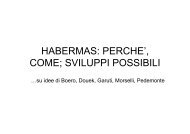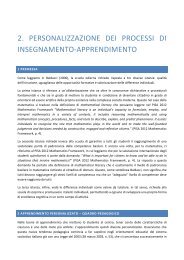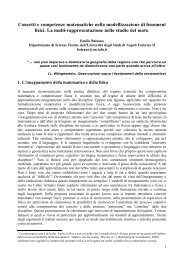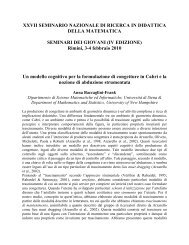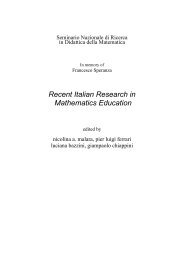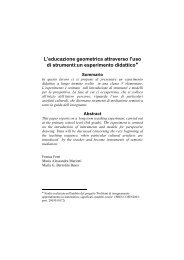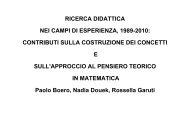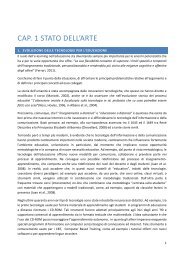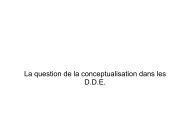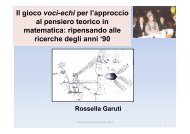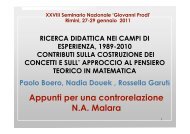vygotsky's everyday concepts/scientific concepts dialectics in school ...
vygotsky's everyday concepts/scientific concepts dialectics in school ...
vygotsky's everyday concepts/scientific concepts dialectics in school ...
Create successful ePaper yourself
Turn your PDF publications into a flip-book with our unique Google optimized e-Paper software.
arguments to <strong>in</strong>terpret and compare the texts concerned “reality” (the known<br />
development of the plants), spatial organisation, and calculations, with their<br />
hierarchical organisation.<br />
Phase 3: Individual synthesis<br />
The teacher brought the students to a synthesis by the follow<strong>in</strong>g question:<br />
Is it the same to say “which plant <strong>in</strong>creased the most” and to say “which plant is the<br />
tallest”? Why?<br />
The generality of this question aims a more <strong>scientific</strong> handl<strong>in</strong>g of the <strong>in</strong>volved<br />
<strong>concepts</strong>. 12 students out of 20 produced a general and valid synthesis, most gave<br />
examples (and some of them were creative <strong>in</strong> do<strong>in</strong>g it). 14 students referred to time. 6<br />
out of these 14 had produced a draw<strong>in</strong>g <strong>in</strong> Phase 1.<br />
A CHARACTERISATION OF SCIENTIFIC CONCEPTUALISATION IN<br />
SCHOOL CONTEXT<br />
Let us now describe <strong>scientific</strong> conceptualisation as we consider it pert<strong>in</strong>ent <strong>in</strong> <strong>school</strong><br />
context, and present a characterisation that allows to evaluate its evolution. We will<br />
use it to analyse the effect of Vgotsky’s <strong>everyday</strong> <strong>concepts</strong>/ <strong>scientific</strong> <strong>concepts</strong><br />
<strong>dialectics</strong> on conceptualisation, as well as the conditions that helped this dialectic to<br />
take place. This characterisation captures two entangled aspects: the epistemological<br />
construction, and the development of cognitive activities. Vygotsky (1986; cf<br />
Vergnaud, 2000) helps us to recognise the quality of the use of the concept, and its<br />
evolution. Vergnaud (1990) helps us to recognise explicit l<strong>in</strong>ks with experienced<br />
“reality” through reference situations and external representation; and with subject’s<br />
activity <strong>in</strong>terpreted through operational <strong>in</strong>variants 1 . External representation, <strong>in</strong><br />
coherence with the experience field didactical theory, <strong>in</strong>cludes gesture and language<br />
<strong>in</strong> the broadest way (cf Radford, 2003). We consider two characters of<br />
conceptualisation and at the same time we try to describe how to detect them:<br />
- The evolution of systemic l<strong>in</strong>ks of <strong>concepts</strong>. L<strong>in</strong>ked objects can be reference<br />
situations, external representations, other <strong>concepts</strong>, or components of <strong>concepts</strong><br />
(accord<strong>in</strong>g to Vergnaud’s def<strong>in</strong>ition). L<strong>in</strong>ks can be propositions about the objects<br />
(e.g. propositions that express properties, characteristics, analogies or differences or<br />
hierarchies), metaphors, examples, etc. Operational <strong>in</strong>variants or generalisations can<br />
underlie these l<strong>in</strong>ks.<br />
- Students’ awareness <strong>in</strong> handl<strong>in</strong>g the concept, its components or its systemic l<strong>in</strong>ks: it<br />
consists <strong>in</strong> the mastery of the concept, and the <strong>in</strong>tentional recourse to it or to some of<br />
its components, that can be detected specifically <strong>in</strong> us<strong>in</strong>g and express<strong>in</strong>g operational<br />
<strong>in</strong>variants and through us<strong>in</strong>g its external representations.<br />
AN ANALYSIS OF CONCEPTUALISATION IN OUR EXAMPLE<br />
1<br />
Vergnaud def<strong>in</strong>ed a concept as composed by the set of its reference situations, the set of its<br />
operational <strong>in</strong>variants ('schemes', theorems <strong>in</strong> actions, etc.) and the set of its symbolic<br />
representations (see Vergnaud, 1990).



